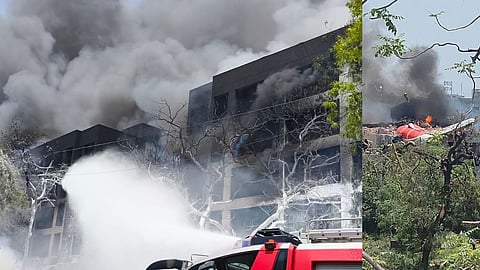

India’s Aircraft Accident Investigation Bureau (AAIB) has found that fuel to both engines of Air India Flight 171 was cut off seconds after takeoff, leading to the crash that killed 260 people, including 19 on the ground, on June 12 in Ahmedabad.
The preliminary report, submitted on July 11 as per international aviation rules, states that the Boeing 787-8 Dreamliner’s engine fuel-control switches were both moved from “RUN” to “CUTOFF” just after the aircraft reached its maximum recorded speed of 180 knots.
The flight was headed to London and was airborne for less than 40 seconds before crashing into a densely populated residential area near the Byramjee Jeejeebhoy medical college and civil hospital.
The report notes that the two switches moved one second apart. Investigators believe the time gap aligns with how long it would take for someone to flip one switch after the other manually. These switches are fitted with safety locks and protective guards, making unintentional activation highly unlikely.
Both engines lost power as fuel supply was cut off. The aircraft climbed to a height of 625 feet before beginning to descend. Pilots moved the switches back to the “RUN” position, triggering automatic engine relight. However, while one engine began to recover, the other failed to regain thrust in time.
There was no indication of bird activity, poor weather, or any emergency condition that would have required an engine shutdown. No technical fault has been found so far in the fuel switch mechanism.
The cockpit voice recorder captured one pilot asking the other why he had performed the cutoff. The other replied that he did not. The report does not identify which pilot made which statement. The co-pilot, Clive Kunder, 32, was flying the aircraft, while the captain, Sumeet Sabharwal, 56, was monitoring.
A “mayday” call was made just before the crash, but the voice could not be attributed to either pilot based on the recording.
Both pilots had valid licences and medical certificates. Sabharwal had over 15,600 hours of flying experience and also served as an instructor for Air India. Kunder had around 3,400 hours of experience.
The crash killed 241 people onboard, including 169 Indian nationals, 53 British citizens, seven Portuguese nationals, one Canadian and 12 crew members. Nineteen people died on the ground when the aircraft hit a hostel building.
The sole survivor was, Vishwash Kumar Ramesh, who managed to escape through a hole in the fuselage. Speaking from hospital last month, he said the aircraft appeared to freeze in the air, the lights flickered, and then it struck a building and exploded.
Ramesh carried the coffin of his brother Ajay, who was also on the flight, to the crematorium in Diu.
The AAIB report has not attributed any fault to Boeing or engine manufacturer GE Aerospace. Investigators from Boeing, GE, the US National Transportation Safety Board and the UK are assisting in the probe.
The US Federal Aviation Administration stated that it is committed to acting on any safety risks that emerge. Boeing and Air India are cooperating with the investigation. GE has not made a public comment.
Air India, in a statement, said it stands in solidarity with the families affected by the crash and is fully cooperating with all authorities involved in the investigation.
Both black box recorders were recovered—one from the rooftop of the crash site on June 13 and the other from the debris on June 16.
The report notes that the investigation remains ongoing and the findings are preliminary. No safety recommendations or warnings have been issued to other operators of Boeing 787 aircraft or GE engines.
Further updates will depend on detailed analysis of the data and additional evidence gathered during the full investigation.